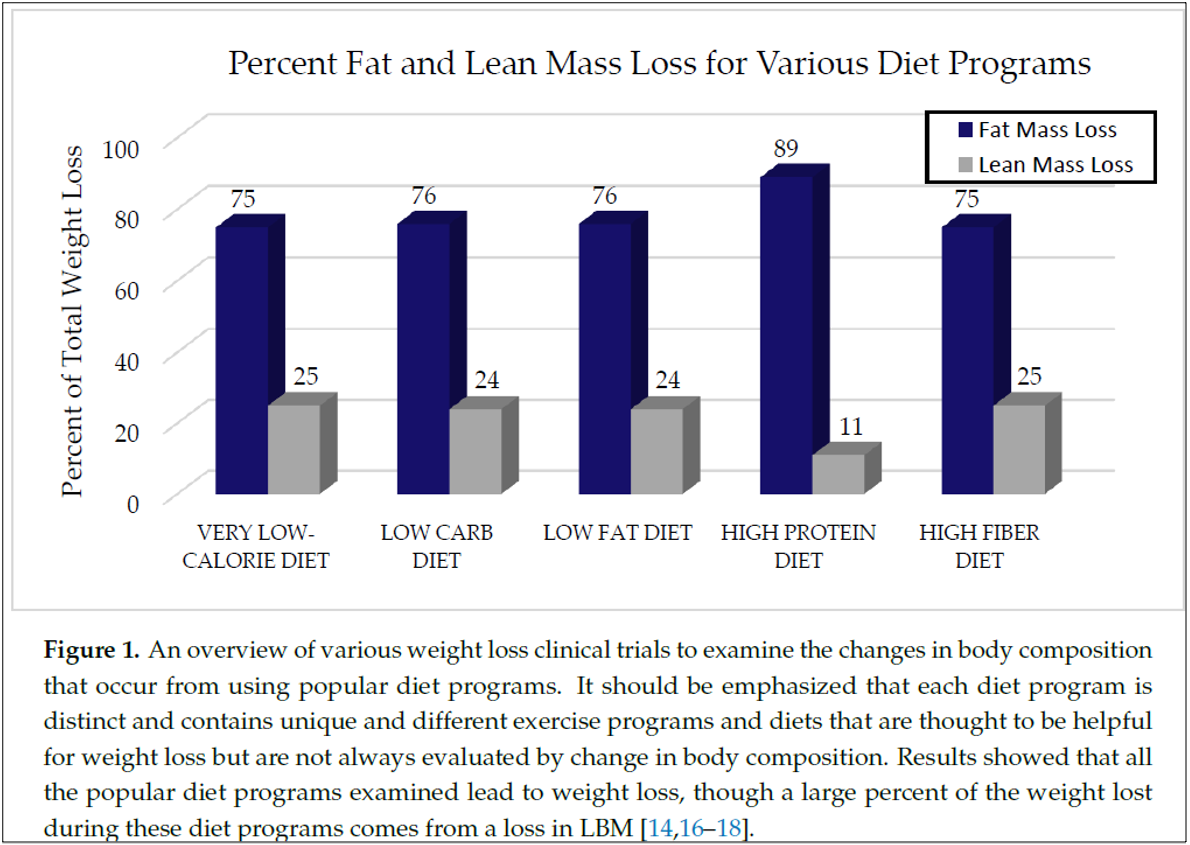Kat Barefield, MS, RD, CPT
Registered Dietitian, Certified Personal Trainer & Tiny Habits Coach
You’re working hard in the gym. You’re eating better and drinking more water. Your body fat percentage is improving but your body weight isn’t changing. Why does this happen? When will the number on the scale start dropping?
This article will answer these questions and more including:
- The difference between fat loss and weight loss
- Why you want to focus on fat loss
- Other ways to measure your progress
- How to adjust your nutrition and workouts to avoid becoming “skinny fat”
Weight Loss vs. Fat Loss
Body weight consists of fat (adipose tissue), fluid, and lean body mass, which includes muscle, bone and organs. When the number on the scale drops, it reflects a decrease in any or all of the above and doesn’t tell us the composition of the weight loss.
When body fat levels drop, it’s specific to one aspect of body weight – fat stores.
Many diets which reduce calories without consuming adequate protein result in more lean body mass being lost, which can have negative repercussions.
For example, researchers reviewed various weight loss diets including low carb, low fat, and very-low calorie diets and found that high protein diets resulted in the most fat loss and the least amount of muscle loss.
The figure below shows the diet comparisons.

Other studies show more drastic results, particularly with rapid weight loss diets during which calories are severely restricted in lean individuals. More on this in a bit.
Why You Want to Focus on Slow Fat Loss
Lean body mass has the biggest impact on resting metabolic rate (RMR). Your RMR reflects the number of calories you need to maintain your weight. The more lean body mass you lose, the lower your RMR. Having a lower RMR makes it more difficult to lose additional weight and increases the chances that you’ll regain the weight.
Rapid weight loss and the loss of lean body mass suppress RMR, a term called adaptive thermogenesis or metabolic adaptation. The body is likely trying to conserve energy in order to survive and perceives a severe energy shortage (calorie deficit) as a threat.
In perhaps the most well-known example of drastic weight loss, a six year follow up on 14 participants of the Biggest Loser TV showed was published in the Journal of Obesity. On average, the participants lost 100 lbs. over 30 weeks with strict eating and intense, supervised workouts while being isolated from friends and family.
All but one participant gained a large portion of the weight back and five regained nearly all or more. Their RMR should have increased with the weight rebound, but remained suppressed, slowing down even further than when they finished the show, indicating metabolic adaptation.
Biggest Loser Show – Results for 14 Participants
|
|
Baseline
|
30 Weeks Later
|
6 Years Later
|
|
Weight (lbs)
|
327.6
|
199.3
|
289.5
|
|
Average Weight Loss (lbs)
|
-
|
128.3
|
38.1
|
|
Body Fat %
|
49.3
|
28.1
|
44.7
|
|
FFM (lbs)
|
166.1
|
141.7
|
154.4
|
|
RMR (kcal/day)
|
2,607
|
1,996
|
1,903
|
|
RMR Decrease Below Baseline
|
|
610 calories
|
704 calories
|
A recent systematic review of studies comparing gradual versus rapid weight loss in overweight/obese individuals revealed the benefits of gradual weight loss:
- Significant preservation of RMR
- Significantly more fat loss
- Greater reductions in body fat percentage
Weight Loss and Hunger
Another reason to focus on fat loss has to do with preventing feelings of extreme hunger, overeating and the dreaded weight rebound.
Severely reducing calories and losing lean body mass has been shown to result in subjects experiencing bouts of uncontrolled eating once they stop restricting calories. Subjects ended up gaining more weight and body fat than before they started dieting until the lean body mass they lost was also regained.
Focusing on slow fat loss and saving as much lean body mass as possible not only makes the weight loss journey easier, but it also makes keeping it off much more likely.
Reasons Why the Scale Isn’t Changing
There are several causes of a stagnant scale number which have nothing to do with whether or not you’re losing fat:
- You’re adding muscle tissue
- High sodium containing foods result in fluid retention the next day.
- Timing of bowel movements
- Fluid intake
- Increasing carbohydrate intake which requires fluid in bodily stores (muscle and liver glycogen)
- Phase of the menstrual cycle
- Inflammation from muscle soreness or injury
- Supplement use – creatine monohydrate can increase intramuscular fluid.
- Medications which influence fluid retention
- Lack of patience
Because your body weight can fluctuate by several pounds on any given day, it’s important to look at your average weight over time rather than focus on daily changes. A three-to-four-week window tells you much more about your progress than daily weight. Patience is required during weight loss to capture true results.
Other Reliable Ways to Measure Progress
Many commonly used body fat devices such as scales or handheld devices are not highly accurate, with many requiring a trained technician and the same conditions each time. What you ate or drank, whether or not you exercised beforehand, and the time of day can all influence the accuracy of body fat measurements.
Therefore, having other reliable ways to capture your progress is key to minimizing frustration and discouragement. Here are some tried and true methods:
- Circumference measurements – particularly around the waist or target areas
- The way your clothes fit, your belt size and your clothing size over time.
- Pictures – side, front and back views
- Practicing new eating habits such as meeting daily protein targets, reducing alcohol intake, and eating more veggies
- Working out consistently
- Taking more daily steps
- Improvements in strength, flexibility and cardiovascular fitness
- Higher energy and stamina levels

Pick a few other ways to measure your progress besides the scale and body fat percentage. If your weight isn’t budging but you’re losing inches, you’re definitely on track. If you haven’t made progress across several measures after 3-4 weeks, it’s time to make an adjustment so you’re in a calorie deficit. That will require reducing the calories you’re taking in (but don’t reduce protein) and possibly increasing your activity level. The exact way to approach this is different for everyone.
How to Adjust Your Nutrition and Workouts to Avoid Becoming “Skinny Fat”
I’ve yet to meet a person who wants to be weaker or have a slower metabolism. To avoid this, a wise approach is to preserve as much lean body mass as possible and focus on losing body fat by using the following methods:
- Lose weight slowly – up to 1% of body weight per week. If you’re already fairly lean, a slower rate is likely better to preserve as much muscle as possible
- Eat adequate protein every day – at least .75 grams per pound of body weight or 1 gram per pound of lean body mass. Whey protein and fiber rich meal replacement shakes are an easy and convenient way to reach the daily target.
- Incorporate diet breaks – either stop dieting for a week or two or maintain a calorie deficit during the week and eat maintenance calories on the weekend.
- Resistance train regularly – at least 2-3 times a week. Be sure to fatigue your muscles if you’re using light weights or doing body weight exercises.
- Incorporate activity that you enjoy and can keep up for a lifetime.
- Celebrate the non-scale victories along the way to reinforce the various ways you’re making progress.
Summary
The scale doesn’t tell the whole story and body fat measurements can often be unreliable, hiding meaningful progress you’re making – particularly if you’re building muscle mass.
Be sure to incorporate other ways of assessing your results such as circumference measurements, the way your clothes fit, and the new healthy eating and exercise habits you’re adopting.
By focusing on fat loss, monitoring your results over time, and adjusting your nutrition and workouts using the aforementioned methods, you’ll become leaner, stronger, and healthier. And for some, perhaps even less obsessed with the number on the scale.
References
Willoughby D, Hewlings S, Kalman D. Body Composition Changes in Weight Loss: Strategies and Supplementation for Maintaining Lean Body Mass, a Brief Review. Nutrients. 2018;10(12):1876. Published 2018 Dec 3. doi:10.3390/nu10121876PMID: 30513859
Fothergill E, Guo J, Howard L, Kerns JC, Knuth ND, Brychta R, Chen KY, Skarulis MC, Walter M, Walter PJ, Hall KD. Persistent metabolic adaptation 6 years after "The Biggest Loser" competition. Obesity (Silver Spring). 2016 Aug;24(8):1612-9. doi: 10.1002/oby.21538. Epub 2016 May 2. PMID: 27136388; PMCID: PMC4989512.
Ashtary-Larky, D., Bagheri, R., Abbasnezhad, A., Tinsley, G., Alipour, M., & Wong, A. (2020). Effects of gradual weight loss v. rapid weight loss on body composition and RMR: A systematic review and meta-analysis. British Journal of Nutrition, 124(11), 1121-1132. doi:10.1017/S000711452000224X
Keys A, Brozek J, Henschel A, Mickelson O, Taylor H. The Biology of Human Starvation. Minneapolis, MN: University of Minnesota Press; 1950.